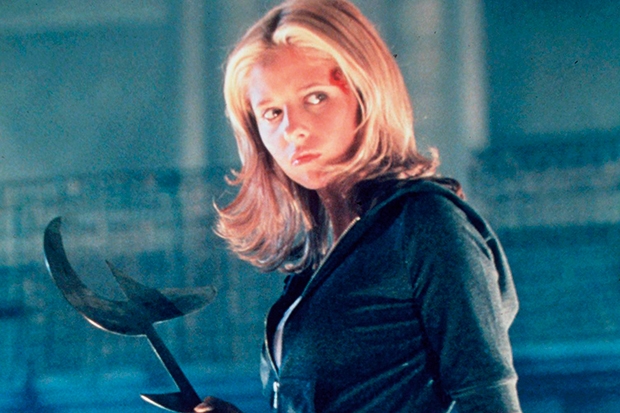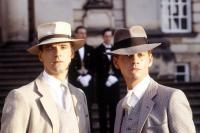Buffy, the Vampire Slayer. Right there, those four ridiculous words, are why it shouldn’t have worked. What was this? Some low-camp Russ Meyer knock-off?
Joss Whedon’s generation-defining TV hit debuted 20 years ago tonight. Its anniversary is being marked by the fans who adored it and the critics whose cool detachment it drove a stake through. It is fourteen years since Sunnydale collapsed into the Hellmouth and Buffy left the airwaves after seven seasons. But far from turning to dust, this unlikeliest of cultural landmarks has enjoyed an afterlife through graphic novels, fan fiction, merchandise, conventions and the long-running chatter about a Hollywood adaptation, a rumour that has proved harder to kill than the show’s durable lead. (She died twice.)
For those of a certain age, ‘vampire hunter’ summons an image of a world-weary Peter Cushing thrusting a crucifix at Christopher Lee and incanting in Latin. With Buffy, it was ixnay on the Ammerhay. This was Bram Stoker younger, sexier and moved to California.
When it appeared in spring 1997, a dozen episodes commissioned to plug a gap in the schedule, expectations were not high for Buffy, the Vampire Slayer. Whedon’s first go at the character, for a 1992 teen flick of the same name, had been hashed by a hammy director. And the concept was still as ludicrous: A Valley Girl, Buffy Summers (Sarah Michelle Gellar), learns that she is the latest in a line of Slayers, warrior women chosen to save the world from the forces of darkness. She is guided in her calling by stuffy British librarian Rupert Giles (Anthony Head), and helped by loveable loser Xander Harris (Nicholas Brendon) and Willow Rosenberg (Alyson Hannigan), a mousy redhead who discovers witchcraft and later lesbianism all while maintaining her 4.0 GPA.
But this was no bubblegum distraction. Buffy was steeped in literary allusions and crackled with pop culture references and became the first TV series to attract serious scholarship. (Arguably, it was also the last; by legitimising academic writing about television fiction, Buffy paved the way for endless semi-lettered tie-ins by fans with PhDs.) Renowned professors wrestled with this high school set study of the human condition while linguists tried to pin down Buffy Speak, the distinctive and playful grammar which animated Whedon’s dialogue. (Inventive, much?) Left and right each claimed it as their own; few productions are treated to competing panegyrics from the American Prospect and National Review. The series finale, aired in spring 2003, prompted a flurry of laudatory essays in the New York Times.
Yes, it was eminently quotable (‘If the Apocalypse comes, beep me’) and frustrating and satisfying were its pleasures; such rage at the dismissive sniggers, such joy at being in the Elect who got it. But Whedon’s purpose was political, or at least revenge. Buffy was his rewriting of 1980s slashers — to rescue ‘the little blonde girl who goes into a dark alley and gets killed in every horror movie’ and make her the hero.
Buffy’s feminism, like all prime-time politics, was broad and irresistible. The series did more to turn a generation onto feminism than the intellectual drudgery of gender studies or po-faced Twitter-scolding that now passes for activism. A safe space? Buffy hung out at the cemetery every night and dusted vamps while gossiping about boys. The only trigger warning she needed was on the rocket launcher she once used to blast a demon to smithereens. ‘Did we not put the ‘grr’ in ‘girl’?’ as Willow once observed.
In the end, that’s exactly what did happen. Buffy and Willow teamed up to unleash the Slayer power across the world. Instead of ‘one girl in all the world’ fighting evil alone, women would now struggle together against the bad guys.
Whedon was more than pop politics and rhetorical acrobatics. He challenged the form of entertainment TV. One storyline, ‘Hush’, saw the characters’ voices stolen and the actors compelled to communicate by gesture for the rest of the episode. Season six’s ‘Once More with Feeling’, in which the Slayer gang finds itself in a musical, remains one of the most ambitious hours of television ever produced. ‘The Body’, a real-time depiction of Buffy coming home to find her mother dead, is a raw, trance-like capsule of loss, regret, and the cruel jolt of forced adulthood.
Buffy was America’s first foray into what came to be known as ‘quality television’. It was, in the rendering of Gail Collins, ‘originally aimed at a teenage audience, then turned out to be for everybody’. It was a show for the outsiders, the geeks; it told us we weren’t alone. And there were more of us feeling alone than we realised.
And that was what set Buffy apart. It was on the surface a series about vampires and the band of misfits thrown together to fight them. But its real themes were innocence lost and the forgotten past. ‘High school is a horror movie,’ Whedon says in explanation of his creation. ‘It’s a horror movie of humiliation and isolation and power and cruelty.’ We forget this when we get older, and romanticise childhood as a carefree time of lingering, balmy summers and formative adventures. That is as fantastical as any world of undead creatures and magic spells.
Whedon wants us to remember the humiliation and the cruelty — to recognise it. He knows that we never really leave high school; we just take out a mortgage and call it growing up. The Buffyverse is not that far from our own world. High school is hell, even if you don’t live on a Hellmouth.
Stephen Daisley is a blogger for Coffee House and a columnist for the Scottish Daily Mail.







Comments